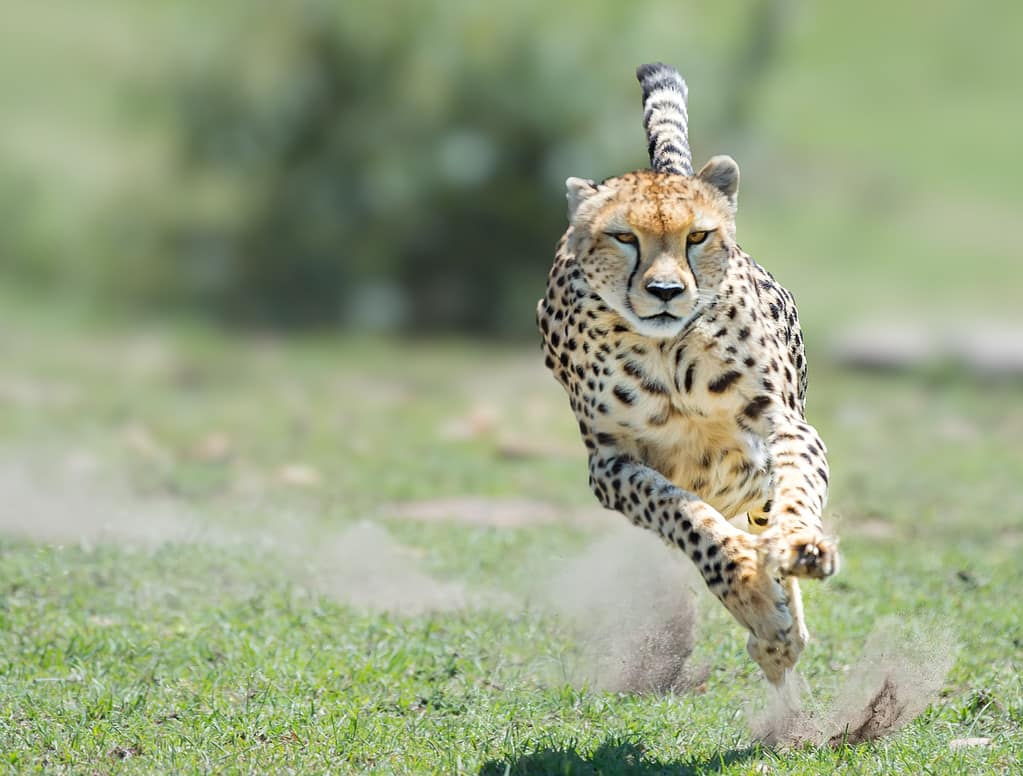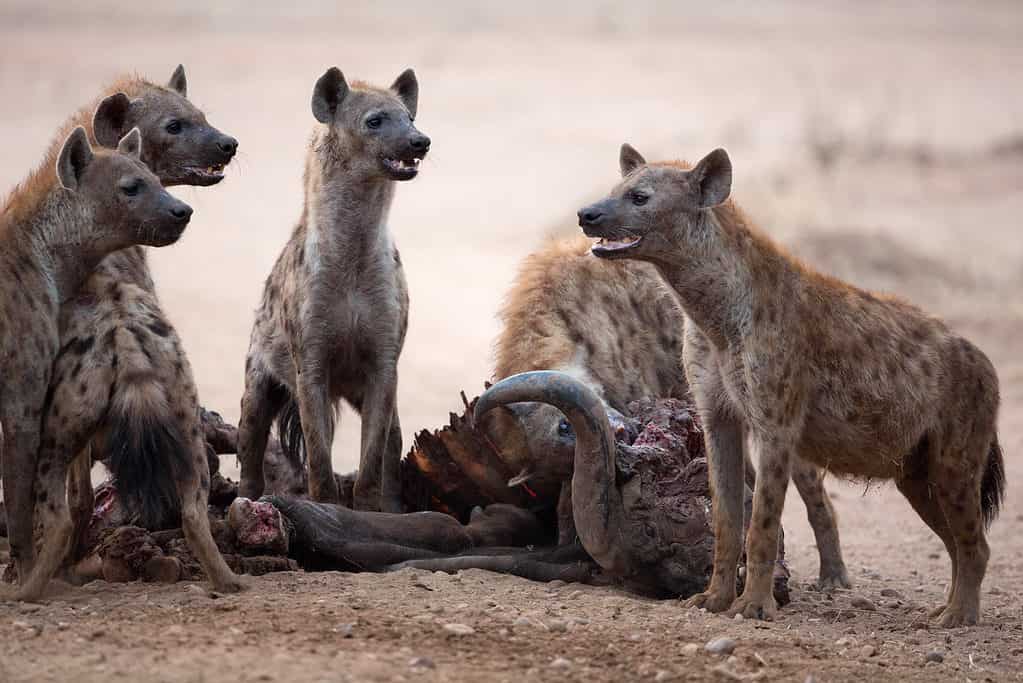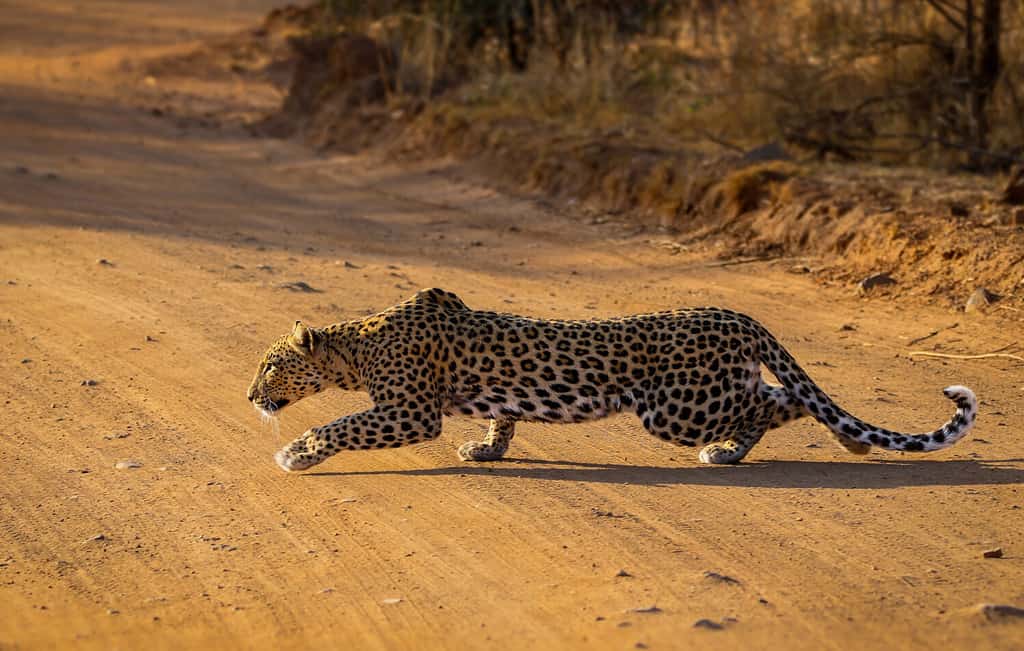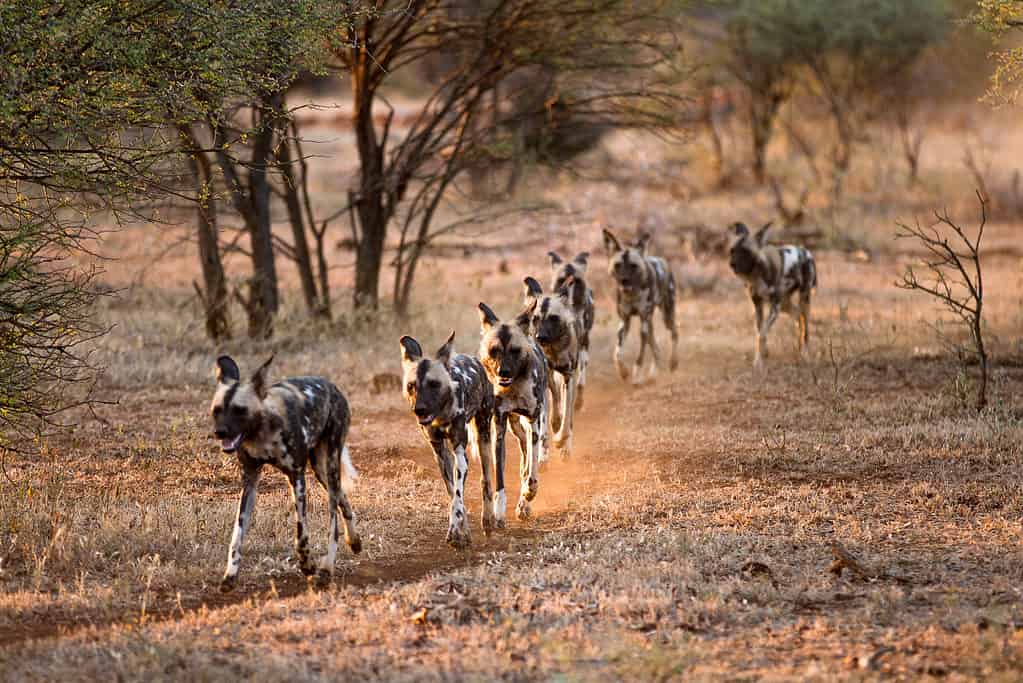The African Savanna has plenty of amazing wildlife. Whether it’s a lion on the prowl or a giraffe getting a drink, this part of the world has become synonymous with spectacular views of nature. There was even a Disney movie about it! (We won’t mention the heartbreaking scenes included). These animals rule the savanna and take advantage of the many other animals living in the area that they can eat. Even though the savanna is sparse and has vast open areas with few natural resources, it still sustains an amazing ecosystem. Many of these predators are at the top of the food chain. They help ensure the delicate balance between the many animals that live in this habitat.
#1 Lion

Lions live in groups called prides on the African savanna.
©CherylRamalho/Shutterstock.com
It wouldn’t be fitting to start our list of predators on the African Savanna with any other than the mighty lion. These animals are apex predators in their environment, meaning that they are at the top of the food chain. They are large and in charge, often weighing between 300 and 400 pounds. Males are known for their hairy manes while female lionesses are famous for their hunting prowess. They eat everything from zebras and gazelles to buffalo and other mammals. Lionesses hunt in small groups or alone to take down prey.
They generally live south of the Sahara Desert and frequent open areas that are warm and have plenty of food. Lions live in prides, which generally consist of one or two male lions, multiple female lions, and cubs. It is common to see as many as 15 lions living together in this family unit. They exhibit many types of behavior within the pride, often playing with each other. The females in the pride run the show, doing everything from hunting to raising the cubs. Lionesses tend to stay with their pride and are related to other lions within the pride. Male lions defend the territory of the pride, although they can be kicked out by rival males who take over. When they reach adulthood, young male lions leave to look for or establish their own pride.
#2 Cheetah

Cheetahs use incredible bursts of speed to run down their potential prey.
©Kandfoto/iStock via Getty Images
The second animal on our list, the cheetah, is the fastest land animal, often reaching speeds up to 80 miles per hour. They live, travel, and hunt alone rather than in packs or prides. Cheetahs are famously solitary animals. The only exception is when they are very young and live with their mothers as cubs or when they are breeding. Some young cheetahs join with other young cheetahs for a short time just after leaving their mothers. But these partnerships are generally short-lived and may just be limited to a particular hunt.
Amazingly, cheetah cubs are born without being able to see, run, or generally fend for themselves. It takes almost three weeks for them to be able to survive without being hidden by their mothers in a den. This is the most vulnerable point of a cheetah’s life and cubs often become snacks for other large predators on the savanna if they aren’t well hidden. Once they make it to around six weeks old, cheetah cubs start to hunt with their mothers to learn the skills they’ll need to survive on the savanna. Cheetahs rely on their speed to get to potential prey, although they have to take down kills quickly. They can only sustain their top speed for a few hundred yards at most. While other predators may have some instincts that help them take down prey, cheetah cubs have to learn it from their mothers.
Cheetahs are endangered, according to the U.S. Fish and Wildlife Service and the Endangered Species Act. Cheetahs are less adaptable than some other animals on the savanna. They also have a much longer and significant vulnerable portion of their life as young cubs. So when human factors like development, climate change, or hunting and poaching make it harder for them to get food and survive, the cheetah population can be significantly impacted.
#3 Hyena

Hyenas eat the entire animal including bones
©Jez Bennett/Shutterstock.com
These predators may not be the largest or the fastest but they are certainly some of the most resourceful. Hyenas are scavengers and let other bigger, faster, or more ferocious predators do the hard work of finding and taking down a kill. The clan then comes in and claims the kill or picks on the scraps left over. Hyenas live and work together, relying on numbers to overpower even predators like lions or cheetahs to get their kills. They live in clans of up to 80 hyenas with a complex social structure. They communicate through cackles, yelps, howls, and a variety of other sounds.
Even though they are known for scavenging, hyenas can hunt on their own. They have very strong bites and can crush bones with their teeth and jaws. There are actually four distinct species of hyenas but the spotted hyena is the most common, named for their spotted coats. They live in many environments, including the savanna. Hyenas are also comfortable in woodlands and mountain regions as well. Because they can adapt to just about any available prey, hyenas can live in many areas.
They eat literally everything they come across, even droppings, carrion, and young hyenas. They tend to go for antelope, wildebeest, and birds when they hunt for their own prey. Coming across another animal’s kill, even if that predator is still eating, is the jackpot for a hyena clan. They’ll drive off the other predator and enjoy the tasty meal themselves.
#4 Leopard

Leopards use stealth to stalk and sneak up on potential prey.
©Heinrich Neumeyer/Shutterstock.com
Another big cat on the African savanna, leopards are powerful hunters with spectacular coloring. There are actually nine different subspecies that live on multiple continents, often distinguished by their spots and coloring. They can be up to 7.5 feet long and as tall as 2.5 feet when they stand on all four legs.
Leopards are carnivores and fearsome predators. They often eat warthogs, impalas, jackals, and other medium-sized animals on the savanna. Unlike some other animals, leopards can adapt to the potential prey that is available. They can eat larger animals, such as impala. But when smaller animals, such as hares or rodents, are available, leopards will go after them just as well. This is important because much of their habitat is impacted by development and fragmentation. After they make a kill, leopards will throw it into a tree to hide it from scavengers.
Leopards are listed as vulnerable, mostly due to decades of being hunted for their fur. Now, it is illegal to hunt leopards in most places. There are some countries that allow leopard hunting, although the requirements are strictly controlled and there may be limitations. That doesn’t stop illegal poaching, however, and leopards remain in danger from illegal hunting. Leopards who live near people can also be killed if they pose a threat.
#5 Wild Dogs

Wild dogs live in packs of up to 30 or more.
©charles Hopkins/Shutterstock.com
African wild dogs have been around for around 200,000 years or more. African wild dogs are a type of canine and are related, even distantly, to other canines such as domestic dogs, wolves, coyotes, and jackals. They roam the African savanna and other parts of sub-Saharan Africa in packs. There are around 40 distinct subpopulations within their range. They are listed as endangered, mostly due to habitat loss, disease, and threats from humans. There are multiple subspecies, mostly identified by where they live.
They live and hunt in packs of up to 40 or more dogs. Like hyenas and lions, they have a complex social structure within the group. This is especially interesting because lions and hyenas are the biggest competitors with wild dogs for food and resources. Unlike some other predators that live in groups, the young pups are often the ones allowed to eat first when the pack takes down a kill.
African wild dogs eat antelope, wildebeests, warthogs, Thomson’s gazelle, impala, zebras, smaller mammals, and others. They have a wide range of prey but will adjust their hunting tactics to the prey that they are going after. Wild dogs work together to either tire their prey out by chasing them down, isolating vulnerable or young animals, or another tactic. They tend not to scavenge and prefer to take down their own fresh kills.
#6 Martial Eagle

Martial eagles have incredible wingspans that help them fly through the air and swoop down to pick up prey.
©Arab/Shutterstock.com
This is the largest Eagle in Africa and a formidable bird of prey on the Savanna. They can get up to 14 or 15 pounds, which is heavy for an eagle. Don’t think that they aren’t powerful in the air, however. They have a wingspan of around 6 feet or more when fully grown, which helps them move through the air to go after prey. Smaller birds and animals, including guineafowl, young goats and lambs, some monkeys, and even small antelopes make up their diet. Martial eagles also eat snakes, lizards, hyrax, mongoose, and even domestic animals. They aren’t picky and as long as they can take down an animal, they’re happy to eat it for lunch. These eagles don’t eat carrion like some other birds of prey, such as vultures.
Their nests are also large and often built high up in large trees. They build nests that are as wide as 6 feet across and up to 80 feet up in the air. This helps protect their eggs and young from other would-be predators. Martial eagles spend a lot of time high in trees, surveying the vast open area of the savanna. They do take advantage of cooler temps, often in the morning, to soar easily through the skies.
These massive birds of prey are seen all throughout the African savanna. They can fly as far as 50 miles, which they often do within a day. They tend to be more prevalent in open areas of the Savanna and don’t frequent forested parts of Africa. Nature preserves like Kruger National Park have viewing spots for martial eagles as well as other species.
Summary of Predators on the African Savanna
| Number | Animal | Potential Prey |
| 1 | Lion | zebra, gazelle, buffalo, and others |
| 2 | Cheetah | antelope, impala, gazelle, and others |
| 3 | Hyena | carrion, antelope, wildebeest, birds, and others |
| 4 | Leopard | warthogs, impalas, jackals, and others |
| 5 | Wild Dog | antelope, wildebeest, warthogs, and others |
| 6 | Martial Eagle | small birds, animals, snakes, lizards, and others |
The photo featured at the top of this post is © kdangelo/Shutterstock.com
Thank you for reading! Have some feedback for us? Contact the AZ Animals editorial team.







